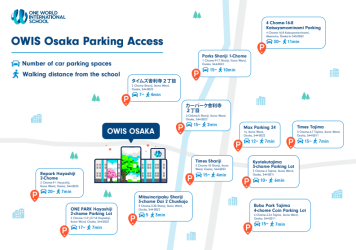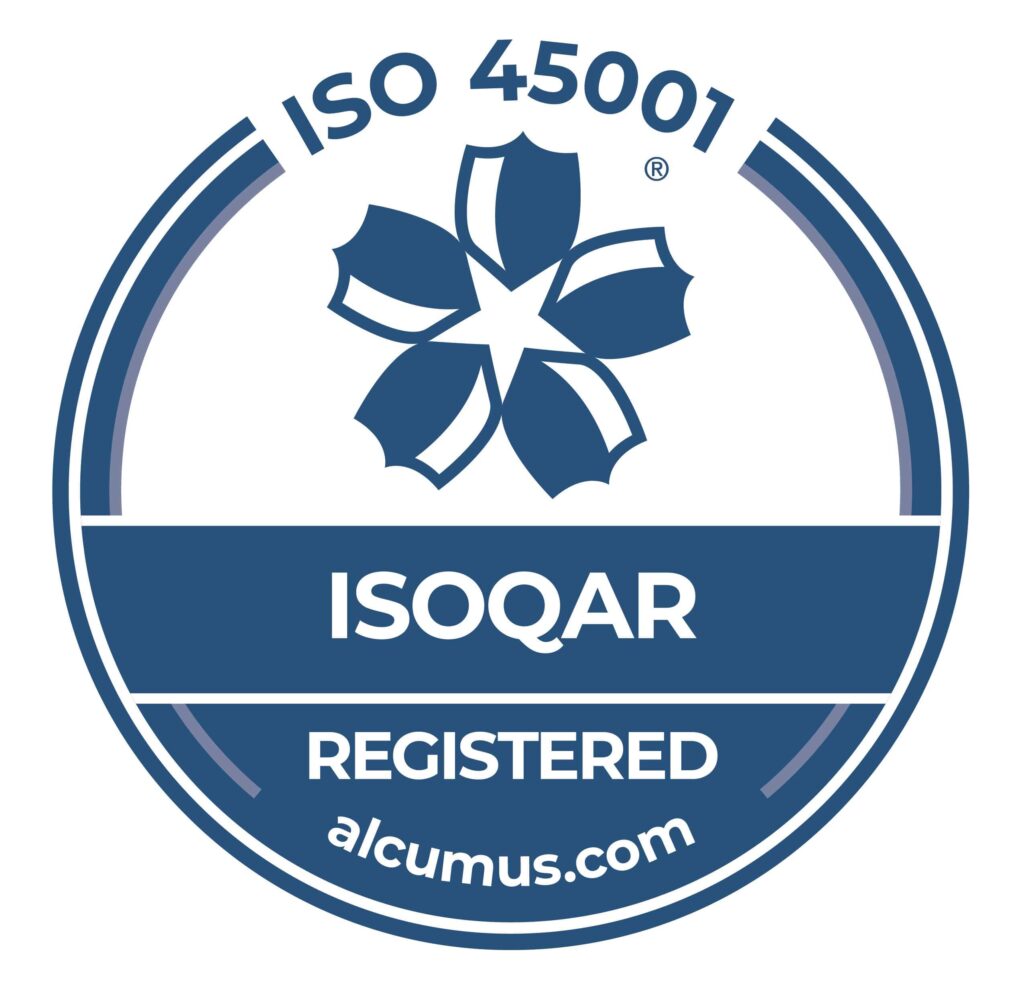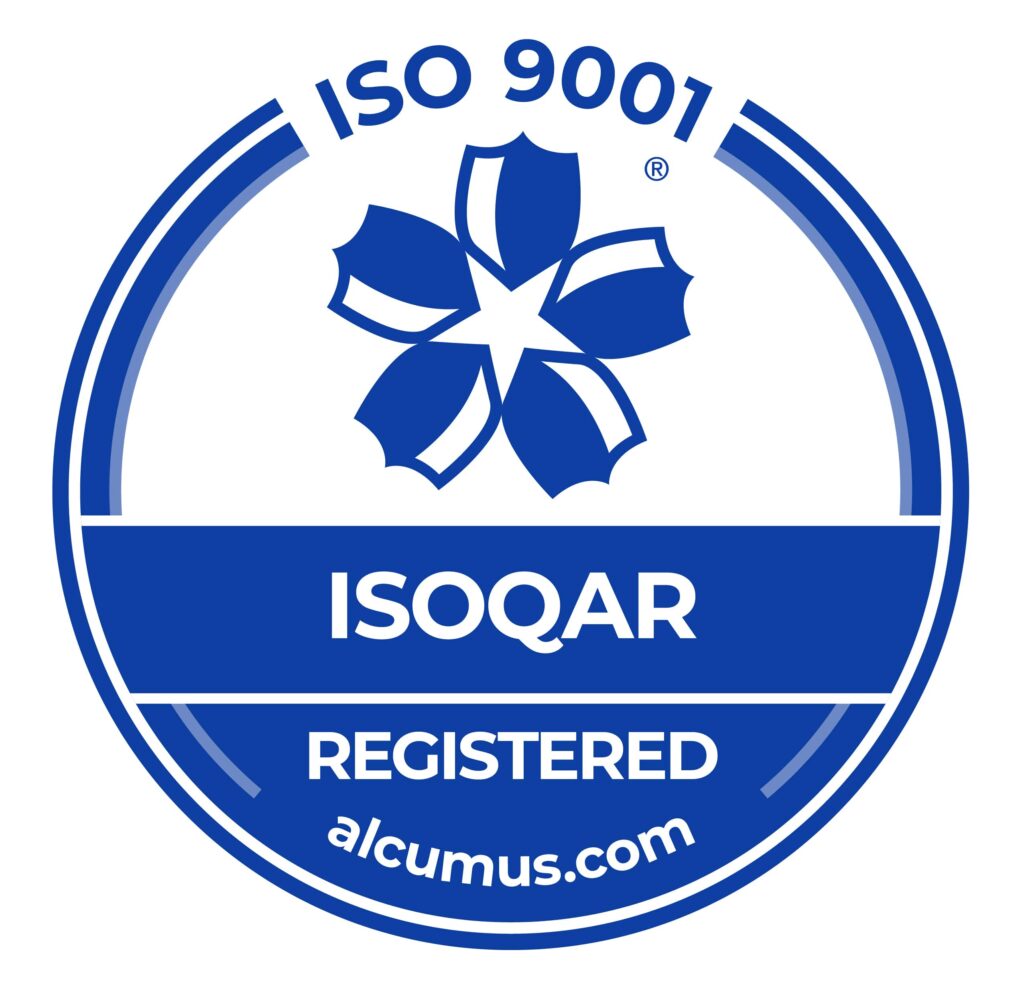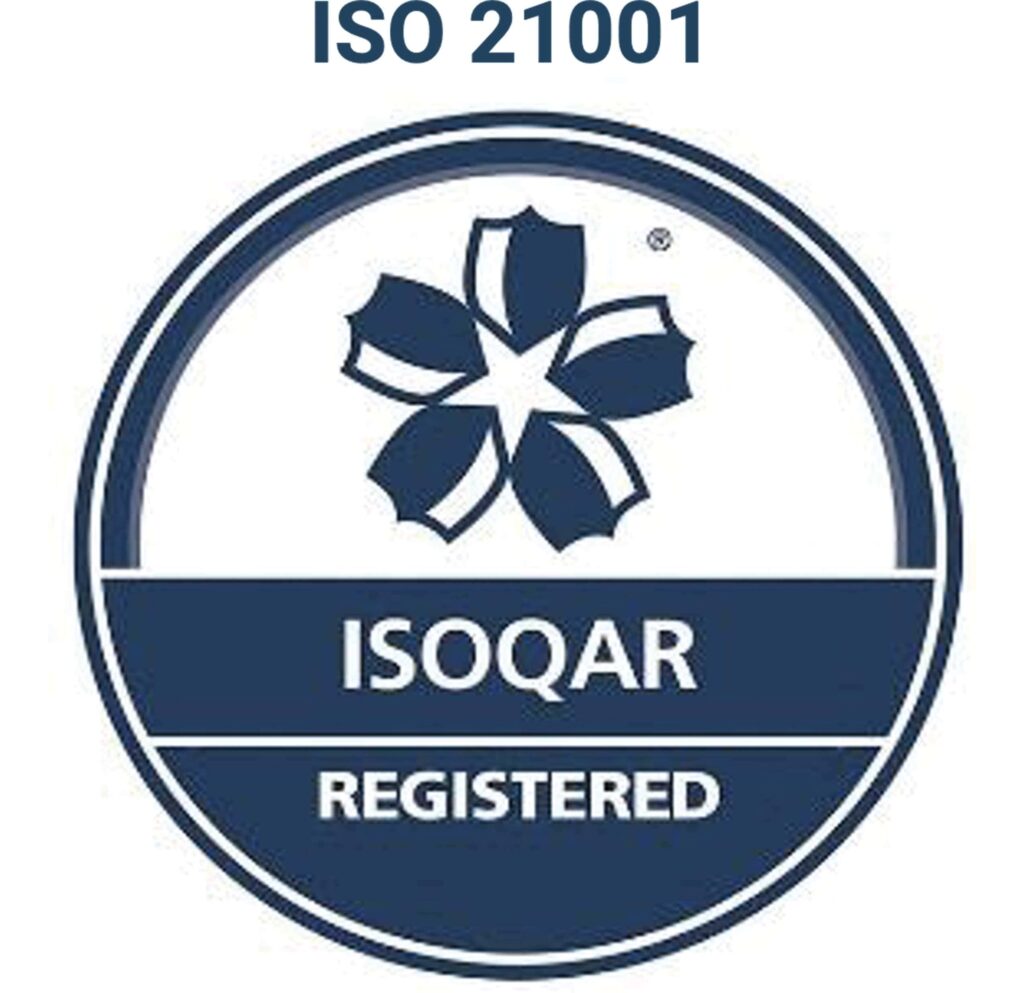As a parent, choosing the right school for your child is a big decision that has long-lasting effects. In Japan, most parents enrol their children in public primary and secondary schools where tuition is free. Despite this, the number of international schools has been on the rise. This trend suggests that, whether for expats or Japanese parents, international schools have become a viable educational option. These schools offer a global education, preparing students for an interconnected world.
When considering your child’s education, explore the differences between traditional Japanese and international schools. This guide aims to provide an in-depth insight into the international school system. To make an informed decision, it’s crucial to understand the features and benefits of these institutions. This will help you determine if this educational path is the right fit for your child.
What Are International Schools?

An international school can be defined as a school that provides international education to a global community. It usually serves students at the K-12 level, but also ages 3–5 and 18–19.
International schools are often found in large metropolitan areas and are attended by children of both expat and local families. They are recognized for having transferable education, a mobile population, multilingual students, international curriculums, accreditation, and English as the primary or bilingual language.
The definition of an “international school” can vary depending on the part of the world you are in. There are however some common key defining features across most international schools, which are; a global curriculum, diversity in languages, and international perspectives.
Key Defining Features of International Schools:
Curriculum: A key feature of international schools is that they provide a curriculum that is different from national schools. These international school curriculums are often recognized worldwide with transferable credits. This makes it easy for students to move easily between international schools around the world, or continue at a similar school when they return to their home country.
Language: International schools will often teach in languages that are different from the host country’s official languages. In Japan, international schools will often teach in English as the primary language. Some schools also teach in other primary languages like German, French, or Chinese.
International Orientation: Another distinctive feature of international schools is their global focus. This is reflected in their goals, characteristics, and philosophy. Their aim is to build an international community that encourages diverse cultures and creates a rich learning environment. Key aspects include providing multicultural education and support to international families.
International schools provide a unique mix of global perspectives, adaptable education, and diverse curriculums. In an era without borders, these schools are critical in developing global citizens. Whether you’re a Japanese parent or a foreign national, understanding international schools helps you decide if it’s the right choice for your child.
Why Choose International Schools in Japan?
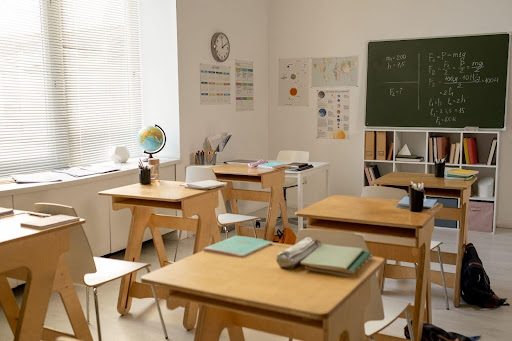
When comparing international schools vs traditional Japanese schools, there are differences in educational approach, language, personal development, and global preparation. Other key aspects to consider include cost, admission processes, language acquisition, and education quality.
In Japan, international schools are the pricier option. Despite the higher cost, many expat parents choose them because they prefer a more global education for their children. For this same reason, native Japanese families are also turning to international schools. In addition to a global focus, they are also seeking a break from the academic pressures of the traditional Japanese education system.
To help you evaluate your options, here are some other reasons why you might consider choosing an international school:
Comprehensive Curriculum
Understanding the school’s curriculum is an important first step. It serves as the foundation of your child’s educational experience. The curriculum includes learning objectives, subjects taught, course content, plus teaching and assessment methods. It ensures that your child will receive a quality education that teaches essential skills and knowledge.
International schools typically offer diverse curriculums, like the International Baccalaureate (IB), International GCSEs (IGCSEs), the American Common Core Curriculum, the French Baccalaureate, Global Montessori, Cambridge, and the English National Curriculum. This variety allows parents and students to choose an educational approach that aligns with their preferences and future goals.
What makes international curriculums distinct is their emphasis on developing applicable skills. While traditional curriculums often prioritise content knowledge, international schools focus on developing critical thinking, communication, collaboration, and problem-solving skills. This emphasis on practical skills aims to prepare students for success in professional environments and real-life situations.
Student-Focused Learning Approach
International schools stand out for their diverse teaching methods, often prioritising a student-focused approach that encourages independent thinking and personalised learning.
Many international curriculums, such as the International Baccalaureate (IB), strongly emphasise inquiry-based learning. This approach encourages students to explore topics independently, ask questions, and deepen their understanding of subjects.
Inquiry-based learning emphasises freedom, experiential learning, cultural sensitivity, and collaboration. These elements collectively prepare students for real-world situations, making international schools an attractive choice for parents seeking a well-rounded and globally-minded education for their children.
Rich Diversity
A primary benefit of international schools is their richness in diversity. They are known for cultivating a global community that exposes students to different cultures.
International schools also incorporate Multicultural Education. This comprehensive approach aims to foster understanding, appreciation, and inclusion among different ethnic, racial, and socioeconomic groups. It celebrates cultural diversity, promoting a fair and inclusive learning environment.
Choosing an international school is an investment in your child’s education. It ensures that they develop adaptability and an open-minded worldview. This prepares them to make a positive impact in a global society.
Multilingual Advantages
Another benefit of international schools is that they offer bilingual education. This allows your child to develop proficiency in multiple languages. International schools in Japan are typically American or British.
These schools provide unique opportunities for bilingual proficiency, ensuring academic excellence while preserving the native language. Instruction is predominantly in English, providing Japanese families with a unique opportunity for bilingual education. This ensures academic excellence while preserving fluency in the native language.
For families from non-English speaking countries, international schools teaching in their native languages help to break language barriers. This aims to create seamless transitions between different cultural environments.
Choosing an international school ensures bilingual excellence, equipping children with diverse linguistic skills, and cultural adaptability. This gives students a competitive edge and opens doors for more opportunities globally.
Smaller Class Sizes and Tailored Learning
International schools also tend to have smaller class sizes and personalised learning. This is particularly beneficial for children with special needs.
Public schools in Japan also offer programs for students with developmental, emotional, and physical disabilities. However, international schools allow students with special needs to seamlessly integrate into the student body while receiving individualised care and support. This inclusive approach ensures a supportive environment that caters to each student’s unique learning requirements.
Mobility
Moving can be challenging, especially for children. For families that often move due to work relocations, international schools are a good alternative. Because the curriculums are globally recognised, students can continue their education in sister schools around the world. Students can easily transition to a new school and integrate into classes in their age group. The flexibility of the curriculum ensures a smooth return after living overseas.
Administrators at international schools are also experienced with working with mobile families. They specialise in helping students adjust quickly in their school and also to similar schools around the world if they relocate. This can provide a consistent and stable learning journey for your child.
Prepare Students for Global Challenges
International schools offer more than exposure to diverse cultures and language skills. They also provide a unique advantage in preparing students for global challenges. Students learn how to adapt and communicate across diverse cultural contexts.
Students are able to develop critical thinking, problem-solving, research, and collaboration skills. This empowers and equips them to navigate global challenges and make a positive impact.
As a parent, you are not only investing in an education that will help your child excel academically. International school education also prepares them to meet and exceed the challenges of our global society.
Challenges to Consider

Despite their benefits, international schools also come with some challenges that parents should consider.
Financial Implications
As mentioned earlier, international schools often have higher costs than local schools.
For example, at OWIS in Osaka, parents have to pay both enrollment fees and annual tuition expenses. These costs typically range between ¥1,000,000 and ¥2,500,000 per year. They cover various aspects such as tuition, co-curricular activities, transportation, field trips, and administrative fees.
As a parent, you can also ask if the school offers scholarships or financial support. Some schools like OWIS in Osaka offer discounts for parents with more than one child attending the school. Knowing the financial implications will help you budget and plan accordingly.
Admissions Complexity
The admissions process at International schools can be complex. As a parent, you want to be well-informed and prepared to navigate this process effectively. Different schools have different requirements, and admissions may depend on how well your child does in entrance exams and interviews.
There are also assessments, essays, and specific documents that need to be submitted. Some popular schools have waitlists, which may make it challenging for your child to secure a spot. It is important to fully understand how to navigate the admissions process for a smooth and successful journey.
Cultural Adaptation
International schools offer diverse interactions. However, students may find it challenging when it comes to adapting to the local culture. In Japan, where Japanese is the main language, attending international schools may limit exposure to the local language and culture. On the other hand, local Japanese children may find it challenging to adapt to international cultures and study in English.
To tackle these issues, some schools implement language support, encourage community involvement, and hire multinational faculty. Schools like OWIS Osaka, provide English support and weekly Japanese classes. This not only supports non-English speakers but also helps international students integrate into Japanese society.
The Difference Between International Schools, Private Schools, and Public Schools
As a parent living in Japan, you can choose to send your child to a public school, a private school, or an international school. Each school has distinct features and understanding the differences will help you to make an informed decision.
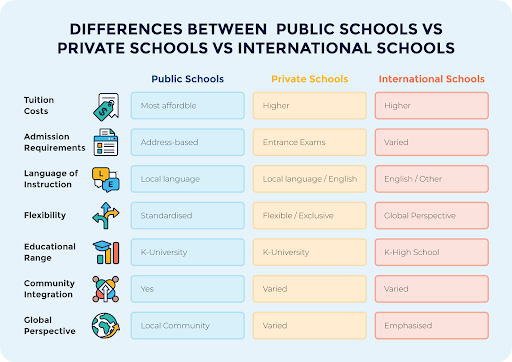
Public Schools:
Of the three options, public schools are the most affordable. The school your child is admitted to will be determined by your residential address. The school administration is organised by districts (i.e. The Osaka District Board of Education). Classes are taught in Japanese (the local language). Public schools generally cover kindergarten to university. Their priority is to integrate students into the local community and build community ties.
Private Schools:
On the other hand, private schools tend to have higher tuition costs. This gives parents the freedom to choose where to send their children. However, there are usually specific admission requirements, such as entrance exams. Some private schools may offer subjects in English. This contributes to a more diverse curriculum. Private schools also cover education from kindergarten to university. Private schools are known for being flexible and exclusive. This is different from the public education system which is more standardised.
International Schools:
International schools aim to accommodate foreign, expatriate, or bicultural students. Tuition fees tend to be higher, which helps to support their specialised programs. They offer education from kindergarten to high school, focusing on an international curriculum. English is the main language of instruction with other languages being offered as optional subjects. Many international schools follow accredited curriculums such as the International Baccalaureate (IB) and Cambridge A Levels. These schools have an international focus, providing students with a more globally-oriented educational experience.
Factors to Consider When Choosing an International School
When choosing an international school, several factors should be considered. These factors will determine the educational experience for your child, how well they adapt, and their overall well-being. Understanding these elements will help you do a full evaluation and make an informed decision.
1. Curriculum
When selecting an international school, understanding the curriculum is important. This will give insight into the teaching approaches and subjects covered. Consider factors like emphasis on inquiry-based learning, transferability to your home country’s curriculum, and assessment methods to ensure it suits your children’s needs.
2. Assessment Methods
It is also important to look for a school that goes beyond traditional testing and uses various assessment methods—written, oral, practical, teacher observations, coursework, and essays. Practical assessments help to develop critical thinking, problem-solving, and independent learning. By carefully considering the assessment method you can prepare your child for the future in other ways besides academic performance.
3. School Year Schedule
In Japan, the academic year runs from April to March. The academic year for different International schools varies. Many have rolling admissions that accept enrollment throughout different parts of the year.
Knowing the academic year schedule is important for families that relocate internationally. Aligning the school year schedules between the countries you are moving from and to ensure a simple transition for your child. This prevents disruptions and minimises waiting periods. This coordination is also helpful if you have children of different ages attending various schools. Aligning their academic calendars streamlines holidays and allows for continuity in their education.
4. Languages Taught
Teaching children other languages is important for understanding different cultures. It also helps them have access to future opportunities. International schools usually offer both the required language and extra optional languages. When choosing a school, make sure they teach in the language that you want your child to learn, and at the right level.
5. Language Support
If the language of instruction isn’t your child’s first language, they may need extra help to do well academically. International schools, being diverse, often provide language support. This could mean in-class help or separate classes to improve language skills.
It should be noted that not all schools offer this support. Additionally, some schools may require language proficiency at a certain level for admission. Make sure to check if the schools you’re considering have the right language assistance for your child.
6. Accreditation
Parents should also look for international schools with accreditation. This allows students to easily transfer credits, receive a well-rounded global education, and enhance credibility that will prepare them for acceptance into university.
Accreditation ensures a smooth educational journey for students and signifies the school’s quality and global recognition.
7. Extra-curricular/Co-curricular activities
Participating in extracurricular activities is essential for children to explore their physical, creative, and social interests, fostering a well-rounded education.
International schools often offer a variety of options, including sports, arts, and community service. When evaluating schools, it’s wise to check for the availability of specific activities your child is interested in, considering age groups. This ensures your child can engage in activities aligning with their passions.
Step-by-step Guide for Parents to Choose the Right School

Step 1 Create a List of Priorities
- Identify Must-Haves:
Start by listing essential criteria that are non-negotiable for you (e.g., specific curriculum).
– Example: The school must offer the International Baccalaureate curriculum.
- Note Nice-to-Haves:
Identify elements you hope to have, but can live without if necessary.
- Example: Extracurricular activities, advanced facilities.
- Consider Your Child’s Individual Needs:
Tailor priorities based on your child’s interests, talents, and learning style.
- Example: If your child loves music, prioritise schools with strong music programs.
- Factor in Logistics:
Consider practical aspects, such as proximity to home and future plans.
- Example: If walking to school is crucial, narrow down options within a short distance.
- Evaluate Academic Background:
Be aware of your child’s academic strengths and weaknesses to find a suitable academic fit.
- Plan for the Future:
Consider your family’s long-term plans, whether it’s a temporary stay or a more permanent settlement.
- Finalise Top Priorities:
Decide on the top three or four priorities and a few additional factors for your ideal school.
Step 2: Shortlisting Schools
- Use Search Tools:
Utilise the International Schools Global website for a comprehensive school search in your city.
- Filter Results:
Narrow down options based on your list of priorities.
- Create a Shortlist:
Identify schools that meet all your must-have criteria.
Step 3: Further Evaluation
- Flexibility Check:
If no school meets all must-haves, consider being flexible with your requirements.
- Explore More Options:
Look into additional school profiles to discover schools you may have missed or overlooked.
- Single School Scenario:
If only one school meets all criteria, schedule a visit to ensure it aligns with your expectations.
- Multiple Options:
If many schools meet must-haves, compare them against nice-to-haves to narrow down choices.
Step 4: Conclusion and Final Decision
- Arrange School Visits:
Before enrollment, visit shortlisted schools to verify alignment with expectations.
- Make An Informed Decision:
Consider all aspects before making the final decision for your child’s education.
Final Thoughts
When deciding on your child’s educational path, it is essential to carefully weigh aspects like curriculum, assessment methods, language support, and extracurricular offerings. This decision is especially important when evaluating the options between the traditional Japanese school system and international schools.
Have you thought about how your child’s education influences both their academics and how they perceive the world? Japanese schools offer a community-centred approach at an affordable cost. On the other hand, international schools, like OWIS Osaka, provide a globally-focused education with an emphasis on critical thinking and language proficiency.
In today’s connected world, more parents are leaning towards international schools over highly-regarded traditional schools in Japan. These schools go beyond academics; they offer a diverse, multicultural experience.
They provide language learning programs, networking opportunities, and a holistic education that focuses on developing character as much as academic performance. Throughout this guide, we’ve explored what sets international schools apart. By carefully weighing these aspects, you’re not just deciding on an educational path. You are also paving the way for your child to thrive in an ever-evolving global society.








